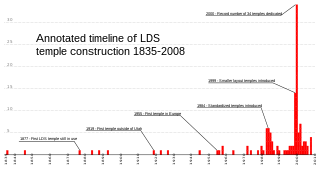
"The Family: A Proclamation to the World" is a 1995 statement issued by The Church of Jesus Christ of Latter-day Saints which defined the official position of the church on family, marriage, gender roles, and human sexuality. It was first announced by church president Gordon B. Hinckley.
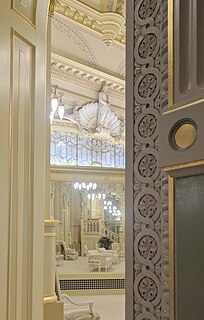
In Mormonism, the endowment is an ordinance (ceremony) designed to prepare participants to become kings, queens, priests, and priestesses in the afterlife. As part of the ceremony, participants take part in a scripted reenactment of the Biblical creation and fall of Adam and Eve. The ceremony includes a symbolic washing and anointing, and receipt of a "new name" which they are not to reveal to others except at a certain part in the ceremony, and the receipt of the temple garment, which Mormons then are expected to wear under their clothing day and night throughout their life. Participants are taught symbolic gestures and passwords considered necessary to pass by angels guarding the way to heaven, and are instructed not to reveal them to others. As practiced today in The Church of Jesus Christ of Latter-day Saints, the endowment also consists of a series of covenants that participants make, such as a covenant of consecration to the LDS Church. All LDS Church members who choose to serve as missionaries or participate in a celestial marriage in a temple must first complete the endowment ceremony.

A temple garment, also referred to as garments, the garment of the holy priesthood, or Mormon underwear, is a type of underwear worn by adherents of the Latter Day Saint movement after they have taken part in the endowment ceremony. Garments are worn both day and night and are required for any adult who previously participated in the endowment ceremony to enter a temple. The undergarments are viewed as a symbolic reminder of the covenants made in temple ceremonies and are seen as a symbolic and/or literal source of protection from the evils of the world.

Washing and anointing is a temple ordinance practiced by The Church of Jesus Christ of Latter-day Saints and Mormon fundamentalists as part of the faith's endowment ceremony. It is a sacred ordinance for adults, similar to chrismation, usually performed at least a year after baptism. The ordinance is performed by the authority of the Melchizedek priesthood by an officiator of the same gender as the participant.
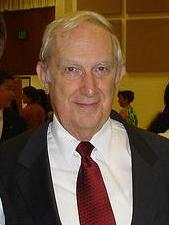
Richard Gordon Scott was an American scientist and religious leader who served as a member of the Quorum of the Twelve Apostles of The Church of Jesus Christ of Latter-day Saints.
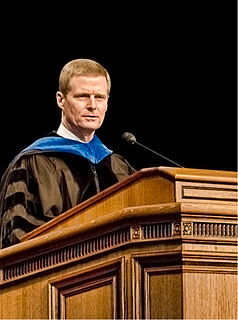
David Allan Bednar is a member of the Quorum of the Twelve Apostles of The Church of Jesus Christ of Latter-day Saints. An educator by profession, Bednar was president of Brigham Young University–Idaho from 1997 to 2004.
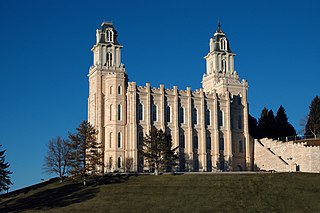
The Manti Utah Temple is the fifth constructed temple of The Church of Jesus Christ of Latter-day Saints. Located in the city of Manti, Utah, it was the third LDS temple built west of the Mississippi River, after the Mormons' trek westward. The Manti Temple was designed by William Harrison Folsom, who moved to Manti while the temple was under construction. The temple dominates the Sanpete Valley, and can be seen from many miles. Like all LDS temples, only church members in good standing may enter. It is one of only two remaining LDS temples in the world where live actors are used in the endowment ceremonies ; all other temples use films in the presentation of the endowment. It is an early pioneering example of four rooms representing the journey of life.

Carl Christian Anton Christensen was a Danish-American artist who is known for his paintings illustrating the history of The Church of Jesus Christ of Latter-day Saints. Of him it has been said that he "did more than any other person to capture the images of the history of Mormon migration to Utah and the life lived there".
The light of Christ is a doctrine of the Latter Day Saint movement, including The Church of Jesus Christ of Latter-day Saints, that is defined as "the divine energy, power, or influence that proceeds from God through Christ and gives life and light to all things." The light of Christ is "the law by which all things are governed in heaven and on earth" and is often said to bestow conscience upon people. The doctrine teaches that the light of Christ is given to every person.

In The Church of Jesus Christ of Latter-day Saints, the Holy of Holies is a room in the Salt Lake Temple wherein the church's president—acting as the Presiding High Priest of the church—enters to act as High Priest of Israel in direct relationship with God, in accordance with the LDS interpretation of the Book of Exodus. Hence, this Holy of Holies in the temple is considered by adherents to be a modern cognate to the inner sanctuary of the Tabernacle and Temple in Jerusalem. The room was also the place where the second anointing ordinance was administered, although, now any room in a temple set apart for this purpose is used.
Below is a chronological list of temples of The Church of Jesus Christ of Latter-day Saints with sortable columns. In the LDS Church, a temple is a building dedicated to be a House of the Lord, and considered by church members to be the most sacred structures on earth. Upon completion, temples are usually open to the public for a short period of time, and then each is dedicated as a "House of the Lord," after which only members in good standing are permitted to enter. Thus, they are not churches or meetinghouses, but rather specialized places of worship. There are 164 dedicated temples, 15 under construction, and 30 announced. Within temples, members of the church make covenants, receive instructions, and perform rituals and ordinances. Additionally, members consider the temple a place to commune with God, seek God’s aid, understand His will, and receive personal revelation.
Yoshihiko Kikuchi has been a general authority of The Church of Jesus Christ of Latter-day Saints since 1977, and was the first native Asian to be called as a general authority of the LDS Church.

Liahona is the official international magazine of The Church of Jesus Christ of Latter-day Saints. It is named after the word liahona from the Book of Mormon. The Liahona is published in 51 different languages from one to twelve times per year, depending on the language. The magazine consists of articles for youth, teens, and adults, all of which are published concurrently in the church's English-language Ensign, New Era, and Friend magazines. The magazine began publication in 1977. The Liahona publishes 415,000 magazines per month in 46 languages.
Emanuel Abu Kissi is a Ghanaian medical doctor, founder of a medical clinic, and leader in The Church of Jesus Christ of Latter-day Saints. He is one of only a few black Africans to have served as an area seventy in the church. He was the official head of the LDS Church in Ghana during its "freeze" in 1989–90, and has worked extensively to increase interfaith relationships in Ghana.
Daniel Hansen Ludlow was a professor of religion at Brigham Young University (BYU) in Provo, Utah. He was also the chief editor of the Encyclopedia of Mormonism, published in 1992 by Macmillan.
In the theology of the Latter Day Saint movement, an endowment refers to a gift of "power from on high", typically associated with Latter Day Saint temples. The purpose and meaning of the endowment varied during the life of movement founder Joseph Smith. The term has referred to many such gifts of heavenly power, including the confirmation ritual, the institution of the High Priesthood in 1831, events and rituals occurring in the Kirtland Temple in the mid-1830s, and an elaborate ritual performed in the Nauvoo Temple in the 1840s.
The House of the Lord: A Study of Holy Sanctuaries, Ancient and Modern is a 1912 book by James E. Talmage that discusses the doctrine and purpose of the temples of The Church of Jesus Christ of Latter-day Saints. Published by the LDS Church, it was the first book to contain photographs of the interiors of Mormon temples.
The name of The Church of Jesus Christ of Latter-day Saints is derived from an 1838 revelation received by church founder Joseph Smith. Leaders of the LDS Church, in recent years, have placed great emphasis on the full name of the church and have resisted the application of informal or shortened names, including the "Mormon Church", the "LDS Church", and the "Church of the Latter-day Saints".


